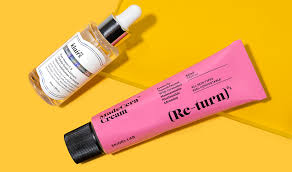
Can You Mix Vitamin C with AHA and BHA?
When it comes to the vast world of skincare, there tends to be a lot of confusion surrounding chemical acids, and how they work in your routine. It will appear some of us are still a little hesitate about using the likes of AHAs and BHAs, so it’s understandable how the thought of using vitamin C with them will feel overwhelming. Well, it’s time to stop panicking, as we are here to help demystify everything and with any luck by the end of today’s blog post, we would have answered the question, “Can you mix vitamin C with AHA and BHA?”
Before we dive in however, let’s have a quick recap of what these ingredients are and how they benefit the skin.
What is vitamin C?
Vitamin C is a multitalented skin ingredient that has been used within the beauty industry for many years. It has only been recently that this potent powerhouse has been able to shake off the misconception that has surrounded it for many years. That is the fact it’s considered unstable meaning it caused all manner of skin irritation and prevented product formulas to work effectively on the skin. With some well-established, stabilised versions of the ingredient, vitamin C has gained an extensive collection of fans, from dermatologists, skincare experts, and fans. Here are some examples of the benefits you can expect to see when using vitamin C, and if you are wanting to know more about this clever ingredient, check out our fully dedicated blog post.
Vitamin C is packed with antioxidants meaning it can combat the exposure to free radicals, such as pollution, UV rays, and central heating. All of which are known for causing damage to the skin surface.
Vitamin C can boost the production of collagen ensuring the skin is left plumped, vibrant, with a youthful bounce. This is due to vitamin C containing two essential enzymes the skin requires to produce collagen, these are, prolyl hydroxylase and lysyl hydroxylase.
Vitamin C can combat hyperpigmentation, dark spots, and pigmentation on the skin surface. It can reduce the production of melanin reaching the surface and causing the dark spots to become more pigmented. Over time you’ll see a noticeable difference and improvement in the skin tone.
Vitamin C restores glow to the skin, this is from a mixture of its skin brightening benefits, but with consistent use you will see a vast difference in the look and feel of the complexion.
What are AHAs?
AHAs, also known as alpha hydroxy acids, are chemical exfoliants that have established themselves as firm favourites amongst beauty fans. Depending on their structure you’ll find they are either naturally occurring or synthetically blended into an array of skincare products.
The way AHAs work differently compared to physical scrubs, is the fact they work at dissolving the bonds that tie the dead skin cells to the surface of the skin. This enables the acids to slough away the dead skin cell build-up without having to physical scrub them off the face. By ridding the skin of unneeded skin cells, bacteria, dirt, debris, and other impurities you reveal fresh, vibrant, new skin that is healthy, happy, and glowing. Find out more about the skincare benefits of AHAs, check out our dedicated post on Skin School.
What are BHAs?
BHAs, also known as beta hydroxy acids, are considered the cousins of AHAs. Often thought to be more potent and should not be used by those with a dry skin type that is prone to sensitivity as they can be too harsh for the skin.
The main difference between AHAs and BHAs is the fact that BHAs, especially the salicylic acid, which is the most used acid, is oil soluble and have a smaller molecule size meaning they can penetrate further into the skin and reach the lower layers of the skin.
If you wanted to know more about how BHAs work on the skin, check out our Skin School post.
Can you mix vitamin C with AHA and BHA?
The short answer is yes, but only after you’ve established your skin will be happy with it. By this I mean you must first establish you are confident you understand your skin type before attempting to layer these ingredients together. Those with an oilier skin may find it robust enough to use a thoughtful blend of these acids and vitamin C. Before you dash off and start applying these products on your skin however, its best to ensure you have still introduced these formulas effectively.
The easiest way of mixing vitamin C with AHA and BHA is remembering the basic skin rule of applying products from thinnest to thickest formulations. This results in each product is left to deliver optimal results without having to compete with any physical barriers created by thicker formulas. You’ll often find that vitamin C is found in serums and face oils meaning you can opt to use an exfoliating toner enriched in an AHA, such as glycolic acid, or BHA, like salicylic acid before applying the serum. Teaming this with a moisturiser or other serum enriched in hyaluronic acid will give the skin a boost in hydration allowing the skin to lock moisture into place whilst counteracting any potential dryness.
If you do find you develop signs of redness, increased sensitivity, or irritation to the skin its best to stop using all three powerhouses in your routine, and instead alternate when you use the acids. You can do this by either applying the acids on different days, or separate times of the day leaving the vitamin C serum for the morning and your chosen acids for the evening.
Can you use BHA and vitamin C together?
Yes, you can, but only if you use each ingredient properly in your routine. As I have already mentioned using BHA and vitamin C together can be effective, but also quite drying on the skin. To gain optimal results you need to allow enough time between applications for the pH levels of the skin to rebalance and avoid any unwanted irritation.
For the best results, use an exfoliating toner containing a BHA, most likely salicylic acid, after you have cleansed the face. Allow about 30 minutes to pass before you follow this with a serum enriched in vitamin C, finishing off with a moisturiser that is packed with hyaluronic acid and other hydrating ingredients.
If you find that your skin is still showing signs of irritation, then the other option for you is to use your BHA product in the evening to give the skin a deep clean after a day your vitamin C serum has kept your skin protected from free radical damage.
Can you mix AHA and BHA with hyaluronic acid?
Absolutely, the beauty of hyaluronic acid as a skincare ingredient is the fact it can work seamlessly with all manner of other ingredients, even those as potent as salicylic acid and glycolic acid. When layering these powerhouses together it’s often considered best to follow the exfoliating acid with hyaluronic acid as this will ensure any potential dryness is prevented. Instead, the skin will benefit from moisture being locked into the face keeping the protective skin barrier functioning with the correct levels of water. This will result in the skin having the ability to remain healthy and protected from exposure to free radicals and other environmental aggressors.
Can you use glycolic acid and vitamin C together?
Yes, you can use glycolic acid and vitamin C together, but make sure you know what you’re doing! If you have concerns with your skin looking dull and lack lustre, you notice signs of hyperpigmentation, and dark spots, or you have signs of ageing, then glycolic acid and vitamin C is one effective power duo.
You can achieve amazing skin results with these ingredients if you stagger their application as this will help the pH levels of the skin to rebalance and sidestep any flare-up in irritation. We go into more detail about how to use glycolic acid and vitamin C together on our dedicated blog post over on Beauty Insiders.
How to use salicylic acid and vitamin C together?
The difference with salicylic acid and glycolic acid is the fact that the molecular size of salicylic is significantly smaller. This results in it being able to reach the bottom of the pores and unclog them of dirt, bacteria, excess sebum, and other impurities. You’ll often find salicylic acid is highly potent and can often cause the skin to become easily irritated. Glycolic acid is also highly potent, but due to the molecule size being larger it instead works mainly on the outer layers of the skin.
How to use salicylic acid and vitamin C together is down to your skin type and the routine you have already established. This is because, as I have already mentioned applying these ingredients require enough time in between applications or choose alternating times to reap the rewards without any unwanted skin irritations.
There you have more of an insight into how you can mix vitamin C with AHA and BHA, don’t forget to come and follow us on Instagram for more daily skincare tips, product launches, and discounts.


